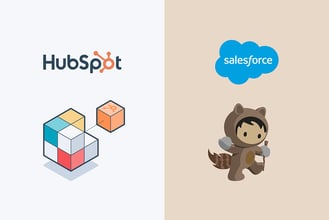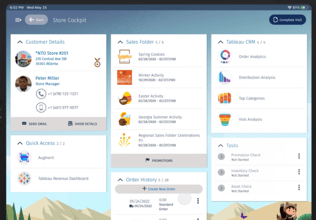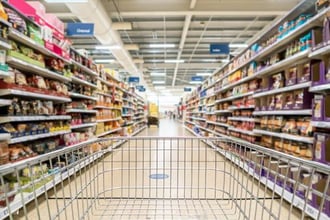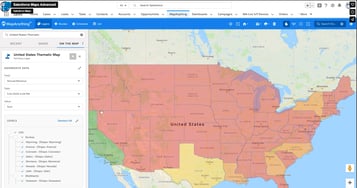Table of contents
Consumer Package Goods (CPG) companies are increasingly using intelligent cloud-based software and Salesforce's Consumer Goods Cloud (CGC) is one such industry-specific platform. If you’re a leader in the CPG industry and want a solution for optimizing sales performance, this definitive guide to the Salesforce Consumer Goods Cloud is for you. It will teach you everything CPG companies need to get started, whether it's to develop your Go-to-Market strategy or take revenue growth to the next level.
Consumer Packaged Goods Industry Challenges
The digital age and higher incomes have brought numerous opportunities for brands. This is evident in the global eCommerce sector's worth, which is now more than four times what it was in 2015. Although CPG executives have access to modern technology, they still face challenges with their online and offline sales.
First and foremost, geopolitical risks and the global pandemic have caused significant supply chain issues, particularly in relation to international trade. A case in point is the COVID-19 pandemic, which disrupted global supply chains significantly.
The fallout from the COVID-19 pandemic continues to hinder supply chains, even in 2023. Furthermore, the Russia-Ukraine war has had a significant negative effect. This is attested to by the fact that logistics and supply chains on both sides of the Atlantic were impacted severely.
Prevalent supply chain issues include freight charges, container shortages, reduced warehousing space, and shipment delays. More than 600,000 businesses across the world have been impacted by the reliance on Russian and Ukrainian suppliers, with 90% of these businesses being in the United States.
Commodities such as fertilizers, food products, oil, and gas have seen a rise in price. Supply chain issues include freight charges, container shortages, reduced warehousing space, and shipment delays. More than 600,000 businesses across the world have been impacted by the reliance on Russian and Ukrainian suppliers. 90% of these businesses are in the United States.
Businesses in the packaged consumer goods sector have been under great pressure. For them to survive in today’s demanding market, they must adopt greater digital transformation to be more customer-centric.
Every CG executive must now actively pursue prioritizing and digitizing the customer experience (CX) so that customers complete all or part of their journey online. This is especially important when dealing with consumer goods. Today’s consumers expect brands and retailers to improve their customer experience efforts, and B2B clients aren’t any different.
Companies in the consumer goods sector face the challenge of growth. They must find a way to upscale while retaining agility in a rapidly changing environment. Furthermore, there are additional pressures on Route-to-Market strategies. These strategies ensure that products reach their destination most efficiently.
Optimizing the route to market actively lowers the cost-to-serve while promoting increased revenue and client satisfaction levels. In this regard, CPG companies have had to develop new strategies to ensure their products reach their destination most efficiently.
Optimizing the route-to-market can help lower the cost-to-serve, increase revenue, and ensure greater client satisfaction. This is particularly important in the B2B market, where customers expect high levels of customer service and experience.
CPG leaders and retailers must stay agile and adjust to changing conditions. This will help them remain competitive and meet customer needs.
Digital Transformation as the Ultimate Solution
Statistically, 99% of companies in the B2B environment have hastened their digital transformation in the recent past. Most of these companies are involved in consumer goods. On the flip side, companies that continue to resist platforms like the Salesforce Consumer Goods Cloud will inevitably lag.
The challenge, especially for SMEs in this sector is to make practical and financially calculated decisions. For instance, Go-to-Market (GTM) strategies must focus on customers as they outline how a business plans to deliver and sell its products or services to its target audience. They must be aligned with the company's goals and supported by its operational capabilities.
Timing is very important when it comes to digitizing distribution channels. Failure to connect digital and analytics programs is a common reason why projects fail. Conversely, investing too soon could spell disaster.
A primary obstacle for consumer packaged goods (CPG) businesses is striking the right balance between expansion and maintaining profitability. These companies need to generate revenue growth while controlling expenses and optimizing profits.
Nevertheless, achieving this necessitates a comprehensive grasp of consumer desires and the development of effective sales and marketing approaches. CPG businesses also face the difficulty of operating in intricate and diverse marketplaces.
To navigate this challenge, they should identify the most effective sales and distribution channels for their products. They should also find ways to manage any potential conflicts and ensure the channels are in line with the company's objectives.
Although the CPG sector is becoming increasingly competitive, companies with the highest digital and analytics maturity keep creating great value for their customers and shareholders.
What is Salesforce Consumer Good Cloud?
Consumer Goods Cloud is a version of Sales Cloud designed for the consumer packaged goods (CPG) industry. It is part of the Salesforce Customer 360 Platform.
Brands in the consumer goods sector can use this solution to their advantage. It can help them create closer, more collaborative relationships with their entire value chain. Additionally, it can help them grow their business and fulfill their brand promise to consumers.
Thousands of companies have adopted this technology. It is used across food and drink, health and beauty, personal care, and other consumer packaged goods (CPG) industries. It allows these companies to modernize their route to market and optimize their revenue strategies.
Salesforce Consumer Goods Cloud offers an intelligent customer relationship management (CRM) platform for B2B revenue leaders. It allows them to connect with their distribution channel partners in one place. At the same time, it gives them the insights and analytics needed to make smarter business decisions. These decisions can be made time and time again.
Salesforce CG Cloud can also help CPG leaders identify opportunities and support field reps in multiple stores and channels. The ultimate goal is to provide the impetus for increased growth. They do this while working on the powerful Customer 360 Platform, the world's largest and best CRM platform.
Consumer Goods Cloud launched in October 2019 and quickly got adopted by CPG leaders and supply chain managers in the U.S. and other countries. The COVID-19 pandemic led to a surge in companies using the Salesforce extension to complete a digital migration. This was especially true in the B2B field, where human interactions decreased by 52%.
Why Consumer Goods Cloud?
The Salesforce Consumer Goods Cloud suite embraces automation and AI-driven insights. It builds on the success of the world's best CRM software. From planning and execution to analytics, this platform provides a comprehensive solution.
As an industry-specific solution, Salesforce CGC includes online and offline capabilities to empower field reps with efficient retail execution. In addition, the Salesforce mobile app integrates and extends CGC's CRM capabilities.
It also has an offline component, which allows online data to be synced to an offline data model. This ensures field reps can continue working, even when they don't have an internet connection.
As the absolute game-changer for Retail Execution, choosing Consumer Goods Cloud offers numerous benefits to CPG companies, including:
Enhanced Store Planning
Salesforce offers consumer goods companies an optimal solution for effective planning. The Salesforce Consumer Goods Cloud grants sales managers a comprehensive 360-degree perspective of sales targets, orders, promotions, and discounts. It also ensures seamless execution of retail business activities.
For instance, if you run a chain of stores, you can leverage the capabilities of Salesforce CGC to know which stores to visit and what to do to optimize sales. Furthermore, the platform can help with route mapping to help your field teams get to the stores faster.
Superior Store Arrangement
Inventory organization varies across stores. Salesforce Consumer Goods Cloud enables businesses to customize and allocate templates based on store segment categories. These templates can be used for individual stores, boosting productivity from entry to exit.
Precise Shelf Audits
Store shelf maintenance and inventory management become effortless with the Consumer Goods Cloud. The platform allows for streamlined inventory management, expedited planogram creation, and adherence to merchandising standards.
It also serves as a specialized planogram software for visual merchandising, bringing store shelves to management's fingertips. With Salesforce CPG, your teams can scan store shelves and identify out-of-stock. This can help optimize product mix and selling potential.
Easily Manageable Store Visits
Salesforce’s Consumer Goods Cloud enhances the efficiency of field sales representatives by streamlining store visits and activities. Sales representatives can track each store visit. They can also gather essential information such as store name, location, time spent, expected visit times, and previous visits. Quick access to this data makes Salesforce CGC the go-to retail management software.
Move away from static Excel with Improved Forecasting
Salesforce Consumer Goods Cloud significantly reduces dependency on conventional solutions like Excel by offering a more sophisticated and user-friendly forecasting solution. This advanced system streamlines data management and enables organizations to make accurate predictions regarding sales, inventory, and customer trends.
As a result, businesses can make informed decisions, optimize resource allocation, and eliminate the challenges associated with managing complex spreadsheets. Manufacturers, distributors, and retailers can use these features to connect with field reps and other key stakeholders. All data and insights are stored in one place.
Key Capabilities & Value
Salesforce Consumer Goods Cloud stands out from the crowd because of its capabilities. It can facilitate smoother interactions between the brand and its customers throughout the five stages of the customer journey.
Agile operations allow you to utilize data. They also promote collaboration between the members of your value chain and customer experience protocol. An integrated route to market creates a single source of truth. This enables data-driven insights, which can lead to sales growth.
Cultivating loyal customers is key. To do this, CPG leaders must provide convenient and personalized client interactions.
This will secure consistent engagement and increase the likelihood of repeat purchases. Connecting the consumer experience through multiple channels ensures that client experiences reflect evolving conversion paths. This includes transitioning to self-service models. Finally, empowering the connected employee revolves around giving workers, online or in the field, the tools to enhance productivity and automation.
Image source: Salesforce
With Salesforce CGC, it’s relatively easy to oversee key accounts. It accelerates your digital alignment and supports your go-to-market strategy. This can extend to cover your partnerships with distributors, wholesalers, and retail chains.
Streamlined account management eliminates the hassle of manual data input, which can facilitate joint business planning where relevant. It’ll also help with forecasting customer demands and optimizing all value chain processes to bolster performance levels and sales growth.
The capabilities of uniting online and offline elements are arguably most noticeable in relation to optimized field execution. Collaboration with field reps can lead to calculated territory administration. This boosts customers per rep and average profit per sales rep figures. Route plans, task management, and mobile order capture capabilities are all helpful in achieving this.
B2B loyalty management is heavily reliant on the ability to offer channel partners the right promotions at the right time. Delivering better experiences can actively influence habits and increase the company’s mindshare.
Brand awareness is the most common marketing priority. Encouraging customers with incentives beyond discounts will boost your bottom line. CGC can launch partner programs and promotions tailored to each client account. The customization brings greater value to the clients.
As already mentioned, demands from B2B buyers to receive a consumer-grade digital commerce experience have soared in recent times. CGC provides access to data-based insights. It also allows retailers to customize ordering processes and pricing for individual accounts. Variables including their product assortments and order sizes could be used to deliver tailored experiences at the store level.
Architecture Review
Consumer Goods Cloud's reference architecture can be configured in multiple ways. This allows CPG companies to customize it according to their requirements.
Attributes can be divided into two categories: functional and platform capabilities. The architecture map shows how the tools and resources are linked and work together to provide the best results. Furthermore, the architecture is flexible. Its advanced mapping capabilities allow you to create a customized solution for your business.
Image source: Salesforce
This solution uses the right platform features for each part of the B2B sales journey and integrates with other applications in your technology stack. The truly customized approach can subsequently unlock the full power of smooth marketing, sales, and logistics.
A recent market survey established that over half of all modern audiences would happily pay more for a fast and convenient client experience. B2B purchasers are equally as likely to desire this outcome as B2C customers.
Salesforce CGC's functional capabilities mapping starts with Sales. This includes account management, forecasting, and pipeline management. The goal is to ensure sales interactions are consistent and personalized. They should be based on individual triggers and past client experiences so that appropriate actions can be taken.
Sales are closely linked to Channel Management. Channel Management focuses on loyalty and rebate management. This helps to unlock the best customer lifetime values.
Field Execution provides solutions to help workers and suppliers. It primarily focuses on the back-end and internal communication to boost sales productivity and increase revenue opportunities. Moreover, field execution covers key account management, territory management, prospecting, visit management, audit and compliance, and direct store delivery.
The next phase is Service. It includes case management, schedule management, work order management, filed inventory, upselling and cross-selling, and asset management.
Commerce features relate to the buyer experience, site merchandising, catalog management, pricing strategies, order capture, fulfillment, and logistics duties.
Meanwhile, Marketing can be broken down into lead generation, audience management, and journey management.
The final aspect of the functional capabilities is the Community elements, which cover self-service and knowledge-base management systems. By connecting all of those aspects in one platform, CGC users can handle the entire customer journey from one centralized CRM.
The beauty of Platform capabilities is the ability to customize them. This is done by altering the use of platform enablers, intelligence and analytics tools, integrations, and data sources to reflect current and evolving situations.
Intelligent architecture helps retail and consumer products companies align modern tech and automation solutions with their business objectives. This increases resilience in challenging situations. More specifically, it enables teams to reduce costs through increased agility while creating a sophisticated supply chain that drives revenue.
Why Salesforce?
One of Consumer Goods Cloud’s big unique selling points is that it is a Salesforce retail execution solution. Salesforce is used by over 150,000 clients. More importantly, over 90% of Fortune 500 companies use it as their choice of CRM.
It instantly delivers an extra layer of trust that many CGC alternatives cannot match. Salesforce is a giant in the global market. It has been around for almost 25 years and is known for its excellent client service.
The Consumer Goods Cloud has proven itself effective. It accelerates revenue growth from planning to execution. This is a crucial benefit. It extends the world’s most trusted CRM platform to help B2B businesses digitize their revenue generation and client interaction strategies.
Flexibility is another key ingredient in the recipe for Salesforce's success. The omnichannel approach combines digital interactions in both physical and virtual spaces. This allows users to take advantage of AI and real-time data analytics. This helps them to identify logistical problems, as well as B2B customer pain points and demands.
The revenue generation strategy can be customized through Salesforce, unlike any other CRM. This is due to the SaaS provider's close attention to evolving landscapes and challenges. Many other options are no longer fit for the purpose simply because they have not changed with the times.
Connecting with channel partners from anywhere at any time provides accurate data. This data allows leaders to make informed decisions on when to expand or scale their efforts.
Creating a single source of truth through collaboration allows all teams to supply data. This full view of past customer interactions leads to personalized and consistent engagements. Other CRMs exist, but when searching for the best for a consumer goods company and B2B operations, Salesforce's CGC is the ultimate solution.
Best Practices For Salesforce CGC Implementation
Implementing the Consumer Goods Cloud can transform your approach to sales interactions, ranging from awareness to advocacy from B2B clients. Research has revealed that 87% of business-to-business companies are not capable of extracting maximum benefit from buyer intent.
Choosing Salesforce means you won’t need to worry about data privacy and security. Better still, a single view of each account makes it easy to monitor situations and uncover opportunities.
Your teams can become familiar with each other. This helps them work quickly and confidently. There is no risk of confusion or missed communications.
Salesforce CGC provides retail executive planning and field agent management. This can extend to planogram checks, in-store surveys, inventory checks, journey planning, and custom fields. When Salesforce Consumer Goods empowers your teams, those rewards will extend to the clients.
When struggling to master Salesforce Consumer Goods Cloud, do not hesitate to reach out to experienced professionals for help. They can provide you with the necessary support to get started. Contact the learners.ai team to start your journey with CGC for improved B2B sales operations today.



